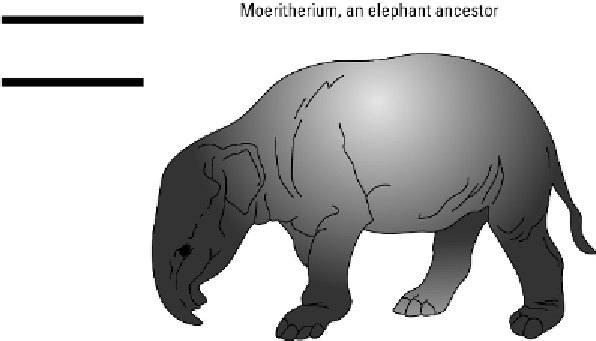Geology Reference
In-Depth Information
Modern elephants are currently the largest land mammals. Only three species exist
today, but throughout most of the Cenozoic era (up until about 2 million years ago),
many more species thrived.
Elephants didn't start out so big. Elephants and their relatives are called
proboscids,
named after their large
proboscis,
or trunk. The earliest known member of this group is
Moeritherium,
which was only about the size of a modern day pig. It may have been
aquatic (like a hippopotamus) and otherwise didn't look very much like an elephant. Fig-
ure 21-5 shows what a Moeritherium probably looked like.
Further up the elephant family tree is a group called
Gomphotherium.
These animals
looked much more like modern elephants. One big difference was that unlike modern
elephant species, which have tusks only on their upper jaws, the
Gomphotherium
had
tusks growing from both their upper and lower jaws. The lower tusks were shovel-
shaped, which scientists believe were used to dig up plants to eat.
The most recognizable elephant ancestors are the
mammoth
(pictured in the color
photo section) and the
mastodon
of the more recent Quaternary period (beginning 2.8
million years ago). The mammoth is more closely related to modern elephant species,
while the mastodon belongs to a more distant branch of the probiscid family tree. Both
mammoths and mastodons roamed through North America until about 13,000 years ago
when they, and many other large mammals, went extinct. (More on this most recent
mass extinction in Chapter 22.)
Figure 21-5:
A
Moeri-therium.
A key difference between mammoths and mastodons was the size and shape of their
teeth. The flat, grinding teeth of a mammoth and more cone-shaped teeth of a mastodon
are illustrated in Figure 21-6.


